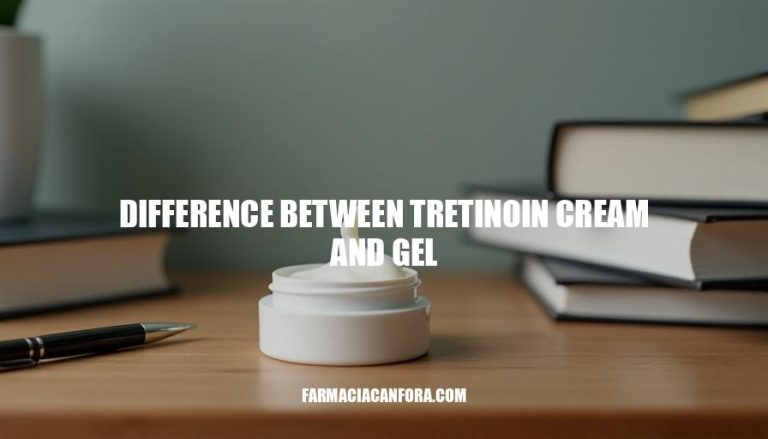


Tretinoin is a powerful vitamin A derivative used in dermatology for healthy skin. It comes in cream and gel forms with different features. Tretinoin cream has emollients that moisturize the skin, making it gentle and suitable for dry or sensitive skin.
In contrast, tretinoin gel is lighter, dries faster, and is best for oily or acne-prone skin as it reduces excess oil.
Both creams and gels help remove dead skin cells and promote new ones, which is key in treating acne by clearing clogged pores and reducing blemishes. Tretinoin also fights aging by producing collagen and reducing fine lines, wrinkles, and discoloration, giving you a smoother, younger-looking complexion. The best option depends on your individual skin needs.
Tretinoin cream and gel differ significantly in their composition, texture, and absorption, which influences their interaction with the skin and suitability for various skin types and concerns.
Composition: Tretinoin cream is formulated with moisturizing ingredients such as stearic acid, glycerol, and mineral oil, making it hydrophilic and rich in emollients. These components help mitigate dryness and irritation, making the cream more tolerable for sensitive or dry skin. On the other hand, tretinoin gel typically contains alcohol-based ingredients like hydroxypropyl cellulose and denatured alcohol, giving it a lighter formulation.
This composition allows the gel to penetrate the skin more rapidly, making it effective for oily or acne-prone skin.
Texture: The cream has a thicker, richer texture, which provides a hydrating effect and a slower release of the active ingredient. This texture is ideal for individuals with dry or aging skin, as it helps retain moisture and reduces irritation. Conversely, the gel has a lightweight and fluid consistency, which dries quickly and leaves a matte finish.
This makes it suitable for individuals with oily skin, as it does not add greasiness and is less likely to clog pores.
Absorption: Tretinoin gel absorbs faster due to its alcohol-based formulation, delivering the active ingredient more efficiently to the deeper layers of the skin. This rapid absorption is beneficial for treating active acne and reducing excess oil. In contrast, tretinoin cream absorbs more slowly, allowing for a gradual release of the active ingredient.
This controlled absorption minimizes irritation and is better suited for prolonged use on sensitive skin.
Interaction with the Skin: Tretinoin cream interacts with the skin by providing hydration while promoting cell turnover and collagen production. It is effective for addressing concerns like fine lines, wrinkles, and hyperpigmentation, especially in individuals with dry or mature skin. The gel formulation, with its rapid absorption and lightweight texture, is more effective for unclogging pores and treating acne.
However, its alcohol base may exacerbate dryness or irritation in sensitive skin.
Suitability for Skin Types and Concerns: Tretinoin cream is ideal for individuals with dry, sensitive, or aging skin, as its moisturizing properties help counteract the drying effects of tretinoin. It is also suitable for addressing anti-aging concerns and improving skin texture. Tretinoin gel, on the other hand, is better suited for oily or acne-prone skin due to its fast-absorbing nature and ability to reduce excess oil.
It is particularly effective for treating active acne and minimizing acne scars.
These differences highlight the importance of selecting the appropriate formulation based on individual skin type and concerns to achieve optimal results while minimizing side effects.
1dailymed.nlm.nih.gov2tretinoins.com3www.accessdata.fda.gov4www.myalloy.com
Tretinoin cream and gel differ significantly in their composition, texture, and absorption, making them suitable for various skin types and concerns.
Tretinoin cream is formulated with moisturizing ingredients, has a thicker texture, and absorbs more slowly, providing hydration while promoting cell turnover and collagen production. It’s ideal for individuals with dry, sensitive, or aging skin.
In contrast, tretinoin gel contains alcohol-based ingredients, has a lightweight texture, and absorbs faster, delivering the active ingredient efficiently to the deeper layers of the skin. This makes it suitable for oily or acne-prone skin, as it reduces excess oil and unclogs pores.
Choosing the right formulation based on individual skin needs is crucial to achieve optimal results while minimizing side effects. If you have dry, sensitive, or aging skin, tretinoin cream may be a better option. However, if you have oily or acne-prone skin, tretinoin gel could be more effective.
It’s essential to consult a dermatologist before starting any skincare treatment, including tretinoin products. They can help determine the best formulation for your individual skin needs and concerns, ensuring optimal results while minimizing potential side effects.